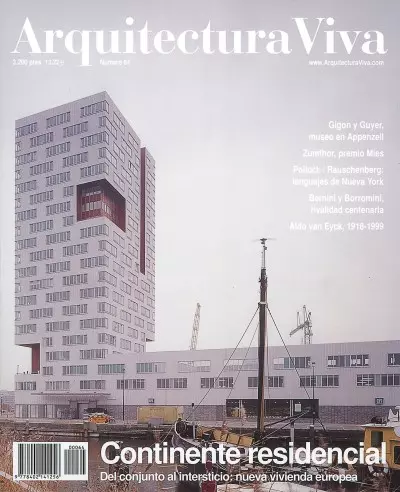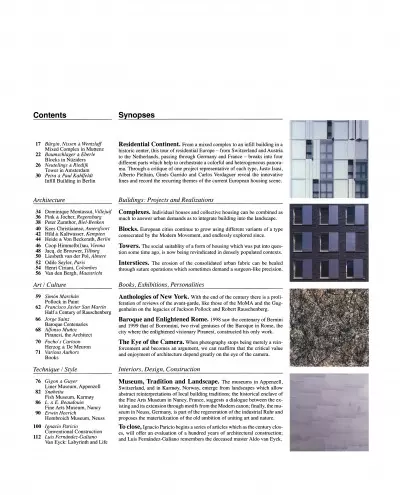Synopses
Residential Continent. From a mixed complex to an infill building in a historic center, this tour of residential Europe – from Switzerland and Austria to the Netherlands, passing through Germany and France – breaks into four different parts which help to orchestrate a colorful and heterogeneous panorama. Through a critique of one project representative of each type, Justo Isasi, Alberto Pieltain, Ginés Garrido and Carlos Verdaguer reveal the innovative lines and record the recurring themes of the current European housing scene.
Contents
Bürgin, Nissen y Wentzlaff
Mixed Complex in Muttenz
Baumschlager y Eberle
Blocks in Nüziders
Neutelings y Riedijk
Tower in Amsterdam
Petra y Paul Kahlfeldt
Infill Building in Berlin
Buildings: Projects and Realizations
Complexes. Individual houses and collective housing can be combined as much to answer urban demands as to integrate building into the landscape. Architecture
Dominique Montassut, Villejuif
Fink & Jocher, Regensburg
Peter Zumthor, Biel-BenkenBlocks. European cities continue to grow using different variants of a type consecrated by the Modern Movement, and endlessly explored since. Kees Christiaanse, Amersfoort
Hild & Kaltwasser, Kempten
Heide & Von Beckerath, BerlinTowers. The social suitablity of a form of housing which was put into question some time ago, is now being revindicated in densely populated contexts. Coop Himmelb(l)au, Vienna
Jacq. de Brouwer, Tilburg
Liesbeth van der Pol, AlmereInterstices. The erosion of the consolidated urban fabric can be healed through suture operations which sometimes demand a surgeon-like precision. Odile Seyler, Paris
Henri Ciriani, Colombes
Van den Bergh, Maastricht
Books, Exhibitions, Personalities
Anthologies of New York. With the end of the century there is a proliferation of reviews of the avant-garde, like those of the MoMA and the Guggenheim on the legacies of Jackson Pollock and Robert Rauschenberg. Art / Culture
Simón Marchán
Pollock in Paint
Francisco Javier San Martín
Half a Century of RauschenbergBaroque and Enlightened Rome. 1998 saw the centenary of Bernini and 1999 that of Borromini, two rival geniuses of the Baroque in Rome, the city where the enlightened visionary Piranesi, constructed his only work. Jorge Sainz
Baroque Centenaries
Alfonso Muñoz
Piranesi, the ArchitectThe Eye of the Camera. When photography stops being merely a reinforcement and becomes an argument, we can reaffirm that the critical value and enjoyment of architecture depend greatly on the eye of the camera. Focho’s Cartoon
Herzog & De Meuron
Various Authors
Books
Interiors, Design, Construction
Museum, Tradition and Landscape. The museums in Appenzell, Switzerland, and in Karmøy, Norway, emerge from landscapes which allow abstract reinterpretations of local building traditions; the historical enclave of the Fine Arts Museum in Nancy, France, suggests a dialogue between the existing and its extension through motifs from the Modern canon; finally, the museum in Neuss, Germany, is part of the regeneration of the industrial Ruhr and proposes the materialization of the old ambition of uniting art and nature. Technique / Style
Gigon y Guyer
Liner Museum, Appenzell
Snøhetta
Fish Museum, Karmøy
L. y E. Beaudouin
Fine Arts Museum, Nancy
Erwin Heerich
Hombroich Museum, NeussTo close, Ignacio Paricio begins a series of articles which as the century closes, will offer an evaluation of a hundred years of architectural construction; and Luis Fernández-Galiano remembers the deceased master Aldo van Eyck. Ignacio Paricio
Conventional Construction
Luis Fernández-Galiano
Van Eyck: Labyrinth and Life
Luis Fernández-Galiano
Residential Continent
Europe is a continent without content. An inventory of its most recent residential architecture confirms this venial diagnosis: the withered maiden suffers from plain emptiness. Devoid of purpose or dreams, her smug life perseveres beneath an elegant and frivolous attire. From the suburban sprawl to the urban interstice, European housing continues to build placid and predictable landscapes, where satisfied inhabitants live the routine of prosperity. Conservative at heart and innovative on the surface, this harmless dwelling combines the convention of types with the invention of skins, and it is in this superficial subversion against the norm where both its tactile and visual lure lies.
While the suggestive seduction of the facades may take us by surprise, the narcotic regularity of the floor plans has more to do with habit than with discovery. Sheltered by its everyday nothingness, the European residence indulges in the matt gloss of geographic privilege, feigning a capacity to defend itself from the violent territory of extreme want: this careened continent only has room for contained contacts, which equally dull emotions and transits. Amid the indifferent equanimity of the European environment, housing construction displays a versatile gamut of eclectic projects, from the towers and blocks of the modern tradition to mixed macles and surgical sutures.
In most cases, the skin of the city is rouged with the refined material of painstaking claddings, and in some the combination of an unexpected form with the impassive beauty of a unique countenance even makes the dwelling stand out in the urban fabric. But though it occasionally takes pleasure in architectural spectacle, in none of the cases is the European residence a dream factory. Long divested of its modern Utopian dimension, where the form of the house was a way of representing the form of the city, and where designing the residential future amounted to designing the urban future, contemporary housing no longer proposes different ways of living: our house sleeps, but dreams not.
Withdrawn in its labyrinth, Europe is reluctant to look beyond its fragile frontiers to the massive crisis of the Islamic world, the convulsions of change in Russia, the muscular disarray of Asia, the deep-rooted horror of sub-Saharan Africa or the brittle hope of Latin America. Perhaps only the dramatic fracture of war on its own soil, with the nightmarish image of the crowds of refugees, can rouse Europe from its barren slumber. And it may be precisely in the ephemeral cities of tents and mud, which shelter the tenacity of the displaced survivors, that Europeans will finally wake up and this fatigued continent will find its insomniac content.








